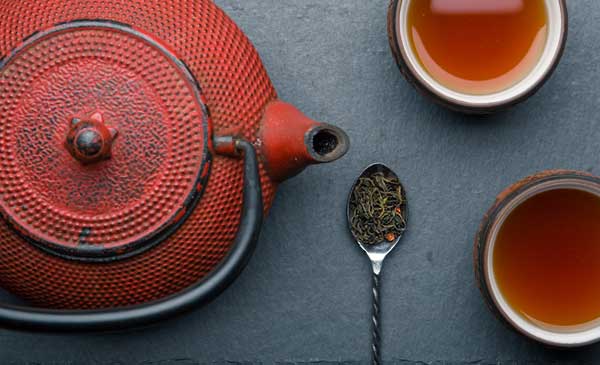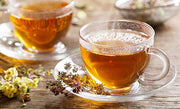Find out: What is Darjeeling Tea?

Most Oolong tea originates in China or Taiwan. However, our rare Darjeeling tea is an Oolong exclusively from the Darjeeling region of India.
Where is Darjeeling in India?
Darjeeling is located in the northeastern part of India, in the state of West Bengal. Nestled in the Himalayan foothills, Darjeeling is renowned for its tea growing plantations. Not to mention the stunning views of the Kanchenjunga mountain range.
What is unique about the elevation and climate of Darjeeling?
The elevation and climate of Darjeeling play a crucial role in the cultivation of its tea. The high altitude of the himalayan mountains ranges from 600 to 2,000 meters above sea level. Combined with its cool climate, the conditions allow for a slow growth of tea leaves, enhancing their flavor profile.
The misty conditions and rich, well-drained soil contribute to the distinct muscatel flavor that people recognize in Darjeeling tea. The temperature variation between day and night in the high elevations helps to develop the tea's aromatic qualities. This makes Darjeeling tea a sought-after choice among tea enthusiasts.

Because the leaves are hand plucked, producers create the best Darjeeling tea in low volume. The Darjeeling tea leaves undergo semi-oxidation and withering under open air and sun. They then roll the leaves by hand and pan-fire them, creating a dark orange liquor with muscatel flavor. Like other true teas, Darjeeling loose leaf tea comes from a Camellia sinensis plant variety.
Is all Darjeeling tea black tea?
Historically, people recognized India for producing Darjeeling black tea. As tea consumption grew around the world, this Indian tea region saw the opportunity. Soon they began producing green tea, white tea, and oolongs as well.
The master tea blender determines the processing method that will result in the tea becoming a black, green, white, or oolong tea.
Darjeeling Oolong combines the qualities of dark and green teas, providing similar health benefits. Green teas have minimal oxidation whereas black teas are more heavily oxidized, turning the tea leaf black. Because producers allow Oolong tea to partially oxidize, it falls between green and black tea.

What does Darjeeling tea taste like?
The nickname "champagne of teas" highlights its high quality. Darjeeling Oolong tea has a delightful aroma and flavor that tea lovers enjoy.
Darjeeling teas can offer a range of unique flavor profiles from floral, fruity, or citrusy and vegetal. The variation comes from its growing environment factors: soil, climate, and elevation.
However our Darjeeling Oolong has a dried muscat grape and apricot pit aroma with a full bodied flavor of tangy dried fruit and deep floral notes. The tea master used a special oxidation process for this Autumnal flush tea. A process that retains the Darjeeling character with elegant autumnal leaves of gold, green, and brown hue.
Farmers harvest Darjeeling three times a year: First Flush, Second Flush, and an Autumnal Flush.
The earliest harvest of the year, the First Flush, is during March and April. After the early spring rain falls on the Himalayas, turning the tea estates a vibrant green, workers gently pluck the leaves.
The Second Flush occurs from late April to June during the rainy monsoon season. The later flush allows the leaves to mature, creating a more complex, muscatel flavor in the infusion. This is evident in the rich color and body of the brew.
The Autumnal flush occurs in October-November. Leaves from this flush will be similar in color to the Second Flush. The body and liquor of the brewed tea will tend to be a bit lighter.

Darjeeling tea benefits
All tea that originates from the Camellia sinensis tea plant offers health benefits with beneficial polyphenols, antioxidants, and flavonoids. The benefits of drinking Darjeeling tea may include controlling cholesterol, lowering blood pressure, and supporting heart health.
Darjeeling Oolong also contains the amino acid theanine, which creates the tea's relaxing effect. Some studies suggest that drinking oolong tea can lower blood sugar levels. This may help reduce the risk of developing type 2 diabetes and obesity. Regular consumption may also help improve bone density.
Does Darjeeling tea have caffeine?
The caffeine content of a cup of Darjeeling tea can vary depending on the flush, the processing method, and the brewing style. Younger leaves from the earlier flush can contain more caffeine. Darjeeling Oolong contains a moderate level of caffeine with about 70 to 120 mg of caffeine. Compared to coffee, it contains about half the caffeine level cup to cup.
Does Darjeeling tea need milk?
Would you put milk in champagne? It's not wrong to add milk if you prefer it that way. But tea connoisseurs consider Darjeeling Oolong a prized tea variety that is best consumed without adding milk.





